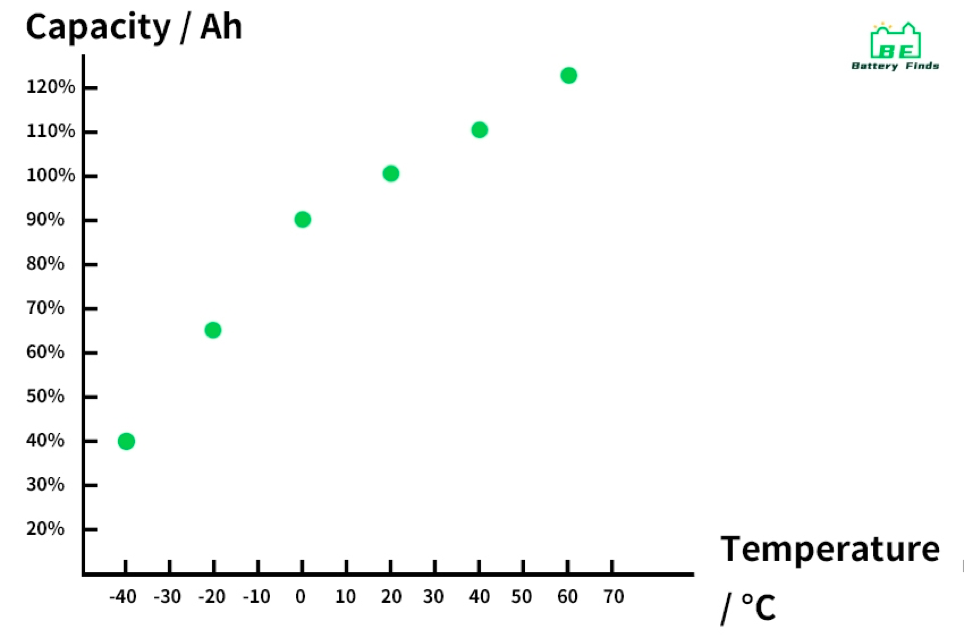
Inquiry
LiFePo4 Battery Operating Temperature Range
Defining LiFePO4 Batteries
LiFePO4 (Lithium Iron Phosphate) batteries, a variant of lithium-ion batteries, come with several benefits compared to standard lithium-ion chemistries. They are recognized for their high energy density, extended cycle life, superior thermal stability, and improved safety features.
How do different temperature ranges impact these batteries?
Capacity:
High Temperatures (Above 45°C or 113°F)
- Increased Self-Discharge: At higher temperatures, LiFePO4 batteries tend to lose charge more quickly, even when not in use.
- Reduced Cycle Life: The lifespan of a battery, in terms of charge cycles, diminishes faster when exposed to high temperatures regularly.
- Potential Thermal Runaway: In extreme cases, very high temperatures can lead to dangerous situations like thermal runaway, where the battery could overheat and fail.
Optimal Temperatures (0°C to 45°C or 32°F to 113°F)
- Balanced Performance: LiFePO4 batteries operate at their best within this range, offering optimal capacity and efficiency.
- Longer Lifespan: Maintaining a battery within this temperature range can significantly extend its useful life.
Low Temperatures (Below 0°C or 32°F)
- Reduced Capacity: The chemical reactions inside the battery slow down in colder conditions, leading to a temporary decrease in total capacity.
- Increased Internal Resistance: This leads to less efficient energy delivery and can cause the battery to work harder during discharge, impacting its overall performance.
- Decreased Efficiency: In general, cold temperatures can make LiFePO4 batteries less efficient regarding energy output and recharge rates.
Voltage:
While it's commonly known that LiFePO4 batteries have a standard voltage of 3.2V, this value isn't constant. Instead, the voltage varies, especially under different temperature conditions.
Consider a LiFePO4 battery at 50% State of Charge (SOC). In temperatures ranging from -20°C to 50°C, this battery maintains a steady voltage between 3.2V and 3.3V. This stability is ideal for both charging and discharging purposes. In contrast, a LiFePO4 battery at 15% SOC experiences more significant voltage swings. For instance, at -20°C, the voltage drops to about 3.0V and only stabilizes around 3.2V at room temperature.
These observations reveal that the voltage of LiFePO4 batteries is influenced by both SOC levels and temperature variations. Batteries with lower SOC are more sensitive to temperature changes.
In terms of everyday energy storage, the impact of temperature on LiFePO4 batteries is generally manageable and falls within acceptable limits, as these storage systems are not in constant use. However, in applications like electric vehicles, where consistent performance is critical, temperature-related variations in battery performance can be more problematic. The diminished performance due to temperature extremes poses a significant challenge in such scenarios.
Tips for Maintaining the Optimal Temperature
- Proper insulation: Ensure that the battery is well-insulated, especially in cold environments. This helps to retain heat generated during operation and prevents heat loss.
- Appropriate cooling: Employ active or passive cooling techniques, such as heat sinks, fans, or liquid cooling systems, to dissipate excess heat during high-temperature operation.
- Environment control: Store and operate the battery in temperature-controlled environments whenever possible.
- Charge management: Avoid fast charging or discharging the battery in extreme temperature conditions to minimize heat generation.
Best Practices for LiFePO4 Battery Care
- Follow Temperature Guidelines: Always operate and store the battery within the recommended temperature range.
- Ensure Proper Thermal Management: Invest in good insulation and cooling systems, especially in environments with extreme temperatures.
- Adhere to Voltage Specifications: Be cautious about the battery's charging and discharging limits to prevent overheating.
- Use Compatible Chargers: Employ chargers that are specifically designed for LiFePO4 batteries to ensure safe and efficient charging.
Conclusion
The operational temperature range of LiFePO4 batteries is essential for their performance, safety, and durability. By following the recommended temperature range, employing appropriate thermal management, and taking necessary precautions, you can maximize the performance and lifespan of your LiFePO4 battery.
Additionally, avoiding common errors like neglecting temperature specifications, insufficient thermal management, and using incompatible chargers will help guarantee the safe and effective operation of your battery.
Our expert will reach you out if you have any questions!


